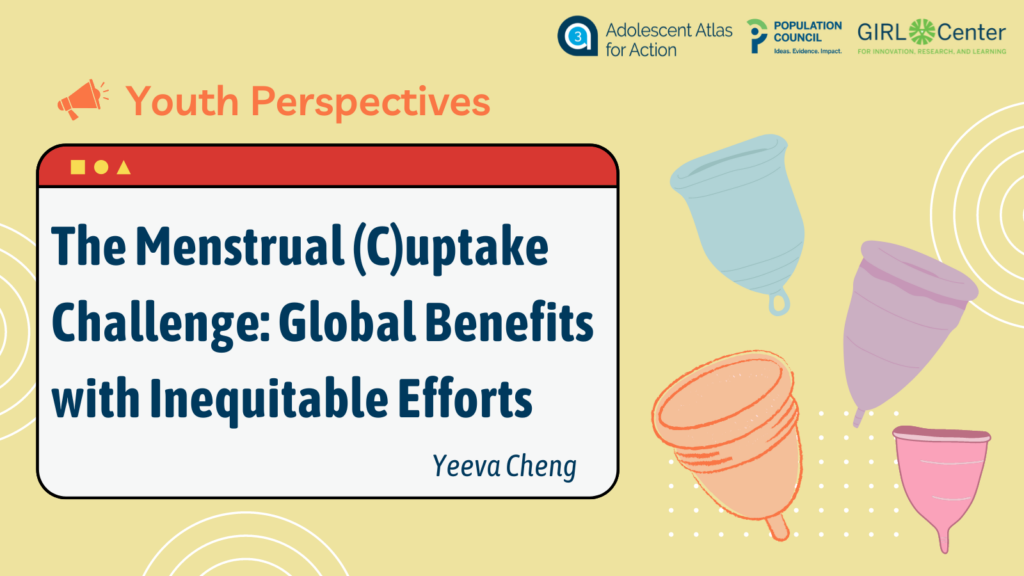The Menstrual (C)uptake Challenge: Global Benefits with Inequitable Efforts
August 12, 2022
This A3 Insights is published under our ‘Youth Perspectives’ series, where Population Council colleagues, fellows, and interns under the age of 30 write a data-driven thought piece focused on their own research interests. This piece is authored by Yeeva Cheng, GIRL Center Intern, while completing her master’s project designing an online menstrual health education course.

Re-Emergence of Menstrual Cups
A recent GIRL Center-led systematic review and webinar examined menstrual health management (MHM) interventions’ impact on girls’ and women’s education and learning outcomes. While further evidence is needed to determine a causal relationship, there is evidence that interventions targeting both menstruators’i access to MHM materials and reproductive health education improve reproductive health knowledge, increase confidence to manage menstrual health at home and at school, and reduce shame about periods.
In recent years, the menstrual cup has gained momentum as both product and intervention. While earlier prototypes of the menstrual cup were patented as early as the 1870’s, menstrual products requiring insertion, such as tampons and menstrual cups, did not become widely commercialized until the 1950’s, particularly with WWII labor demands shifting menstruators toward public-facing work.
Recent menstrual cup re-emergence and advertising target a specific population of menstruators. In the last decade, cups have been mostly promoted in low- and middle-income countries (LMICs). Like the road to uptake in the United States, lifestyle demands such as increased mobility, have driven cup usage, though not without concerns. A second major driver that affects menstruators in LMICs that did not affect 1950’s American menstruators was the looming threat of climate change.
Menstrual Cups Save—Money and the Environment
Menstrual cups today increasingly advertise being environment-friendly and alleviating “period poverty.” Ranging between 10 to 40 USD with a reusability span of up to 10 years, menstrual cups offer the cost-effective potential to respond to menstruators’ challenges. Since then, over 70 menstrual cup companies have flourished, some with buy-one-give-one plans targeting menstruators in high-income countries (HICs) while distributing or funding a cup in a LMIC context. Such designs are critical in that menstrual cups, while potentially saving between 1700 and 4700 USD of tampons or pads per year, render up-front costs less feasible to menstruators in LMICs. In many cases, menstrual cups are not commonly sold in brick-and-mortar stores and still require online purchasing, creating yet another barrier.
Menstrual cups can save a menstruator between 5,000 and 15,000 pads in a lifetime, an appealing statistic to environmentalists. The plastic in disposable pads can require between 500 and 700 years to dispose, and methods such as crude burning are air-polluting. In the U.S. alone, 9 billion single-use period products are consumed each year, with about 80% of these expected to end up in landfills. Even assuming a smaller menstrual product waste footprint in LMIC contexts where disposable materials are used sparingly due to costs, the per capita amount of waste accumulated globally makes the menstrual cup an appealing alternative. Though there have been concerns around menstrual cups and water shortages, a systematic review and meta-analysis on menstrual cup safety, leakage, and acceptability revealed that menstrual cups often result in less use of water when accounting for the water that cloth, cotton, or less structured materials and their leakages might require.
How Educational Policy and Programming Can Reduce Global Period Waste
Menstrual cups minimize both climate and economic costs long-term, but product uptake also requires an enabling environment aided by policy. In building the Adolescent Atlas for Action (A3) Policy Checklist, we checked for the presence of 56 adolescent-relevant national policies in 113 LMICs. These include policies that 1) support MHM education nationally and 2) support MHM education in schools.
Of the 113 countries in the A3 tracker, 22 had MHM policies, and 23 had policy commitments specifically to support MHM in schools. In 10 of these countries, we can observe situations where there are national commitments but not at the school-level, or school-level commitments but no national policies.
Since 2013, UNICEF’s WASH division has focused on countries primarily in South Asia and Sub-Saharan Africa, varying interventions from translating and sharing MHM guides to distributing reusable sanitary pads. However, much of the motivation for promoting reusable and/or natural materials comes down to cost and lack of locally sourced production of materials. While promoting or teaching homemade pad production has been widely popular in LMICs, it is worth noting that these are the contexts that have already been using ecologically safer methods for MHM.
Moreover, LMICs have led innovative approaches to MHM products, curriculum, and integrative policies. Kenya has dedicated research on access to menstrual products in rural and urban areas, contributing to policy written into the Kenyan Constitution’s guarantees toward basic education. Specifically, the Basic Education Amendment Act No. 17 (2017) stipulates a commitment to providing free sanitary towels to all girls enrolled in public education, as well as safe and sustainable means of disposal. Policy Objective 4 lists eight actions outlining how investment, research, and partnerships will collaborate to prioritize recycling, treatment, and waste management. Nepal released a scoping review and preliminary mapping of MHM in 2017, noting commitment to the provision of sanitary pads and disposal facilities. Some policymakers have pointed out that current disposal methods of such products (providing pits and dustbins) are environmentally harmful. Recognizing that it is unfeasible to completely shift away from disposable pads, pragmatic program actions have included installation of disposable pad incinerators in schools to burn pads in an ecologically safe way. While the Philippines has yet to develop a national MHM policy, smaller-scale initiatives have contributed to sustainability efforts. For example, EmpowHer has re-adapted the disposable pad using locally sourced, biodegradable products (corn cob, rice paper, and water hyacinth) that include destigmatizing messaging on the packaging.
Of the countries that enacted MHM education policies in the A3 Policy Checklist, we found none that mention within their policy documentation the distribution of menstrual cups or other reusable products. Where there is mention of menstrual products, language and programming typically focuses on distribution of disposable products. As countries continue to draft policies that provide menstrual products, it is critical to urge an enabling environment for eco-friendly products where possible—not only in LMICs but in HICs, where menstruators can generally exercise greater choice and accessibility. For example, an evaluation report was released in 2018 detailing a pilot program in Scotland that delivered menstruators’ products of their choice, for free. Menstrual cups made up only 2% and reusable towels only 3% of the products distributed; in contrast, disposable sanitary towels (pads) made up 54%, tampons 15%, and a combination of the towels and tampons made up 19%. Interviews with menstruators revealed that many did not know that reusable materials existed, showing initial skepticism. Though many expressed interest in trying a reusable product, few participants followed through with using them.
Cup Concerns
Two major obstacles to menstrual cup uptake remain in LMIC contexts. A common hesitation for menstruators in LMICs entails concerns around inserting an object inside their bodies and reusing the cup. Menstrual hygiene management educational programs that have sought to promote cups often address these concerns and distribute kits including cups and other materials that help respond to these uncertainties as well as promote comfort with one’s body. For example, kits might include a small hand mirror for menstruators to not only help with inserting a menstrual cup, but to also enable an anatomy-based training that is sensitive to new users. Moreover, programs that promote peer and family support are underlined as critical to menstrual cup uptake. Targeting family support not only sensitively responds to sociocultural concerns around virginity and sexuality, but also the issue of privacy users express around routinely boiling or sterilizing their cups around other family members.
Emerging MHM Education
MHM education has yet to emerge as a standard in adolescent-focused policies, but in its early stages, offers opportunity for thoughtful design that integrates climate adaptation. As MHM policies gain uptake, HICs must also make greater efforts and contributions to minimizing climate change. Policymakers might include specific action items including:
✔ Requirements for programs that distribute menstrual products to offer sustainable options, i.e., menstrual cups or reusable pads
✔ Inclusion of menstrual product information within MHM education to inform menstruators about environmental impact of products as well as costs and benefits of products available on the market
✔ Increased partnerships or collaborations between development organizations/agencies and menstrual cup companies to commit to sustainable products
✔ Promote existing buy-one-give-one menstrual cup programs among HIC menstruators
✔ Invest in continued research on ecologically safe methods of menstrual product waste disposal and management
i We use the term “menstruators” here to include any person who menstruates, regardless of their gender identity.
References
About Us – Technology’s Stories. (n.d.). Retrieved December 29, 2021, from https://www.technologystories.org/about-us/
Access to Sanitary Products Aberdeen Pilot: Evaluation Report. (n.d.). 79.
Eijk, A. M. van, Zulaika, G., Lenchner, M., Mason, L., Sivakami, M., Nyothach, E., Unger, H., Laserson, K., & Phillips-Howard, P. A. (2019). Menstrual cup use, leakage, acceptability, safety, and availability: A systematic review and meta-analysis. The Lancet Public Health, 4(8), e376–e393. https://doi.org/10.1016/S2468-2667(19)30111-2
How tampons and pads became unsustainable and filled with plastic. (2019, September 6). Environment. https://www.nationalgeographic.com/environment/article/how-tampons-pads-became-unsustainable-story-of-plastic
How women around the world manage their menstrual period | WaterAid Australia. (n.d.). Retrieved December 6, 2021, from https://www.wateraid.org/au/articles/how-women-around-the-world-manage-their-menstrual-period
Menstrual Cups in Developing Countries. (2020, September 25). The Borgen Project. https://borgenproject.org/menstrual-cups-in-developing-countries/
Menstrual Hygiene Management Enables Women and Girls to Reach Their Full Potential. (n.d.). [Text/HTML]. World Bank. Retrieved December 6, 2021, from https://www.worldbank.org/en/news/feature/2018/05/25/menstrual-hygiene-management
Ruby-Cups-Girls-in-Imvepi-Refugee-Settlement-Taking-Control-03.12.18-Final-report.pdf. (n.d.). Retrieved December 6, 2021, from http://womena.dk/wp-content/uploads/2018/12/Ruby-Cups-Girls-in-Imvepi-Refugee-Settlement-Taking-Control-03.12.18-Final-report.pdf
Sommer, M. (2010). Putting menstrual hygiene management on to the school water and sanitation agenda. Waterlines, 29(4), 268–278.
UNEP-LCI-Single-use-vs-reusable-Menstrual-Products-Meta-study.pdf. (n.d.). Retrieved December 28, 2021, from https://www.lifecycleinitiative.org/wp-content/uploads/2021/07/UNEP-LCI-Single-use-vs-reusable-Menstrual-Products-Meta-study.pdf
UNICEF-Guide-menstrual-hygiene-materials-2019.pdf. (n.d.). Retrieved December 28, 2021, from https://www.unicef.org/media/91346/file/UNICEF-Guide-menstrual-hygiene-materials-2019.pdf
Wash-united. (n.d.). Retrieved December 28, 2021, from https://www.wash-united.org/index.html
White, M. B. and P. (2020, May 28). Effectiveness of User-Friendly Toilets and Pad Vending Machines for Dignified Menstruation. RVWRMP. https://www.rvwrmp.org.np/single-post/2020/05/28/effectiveness-of-user-friendly-toilets-and-pad-vending-machines-for-dignified-menstruatio

 Yeeva Cheng
Yeeva Cheng